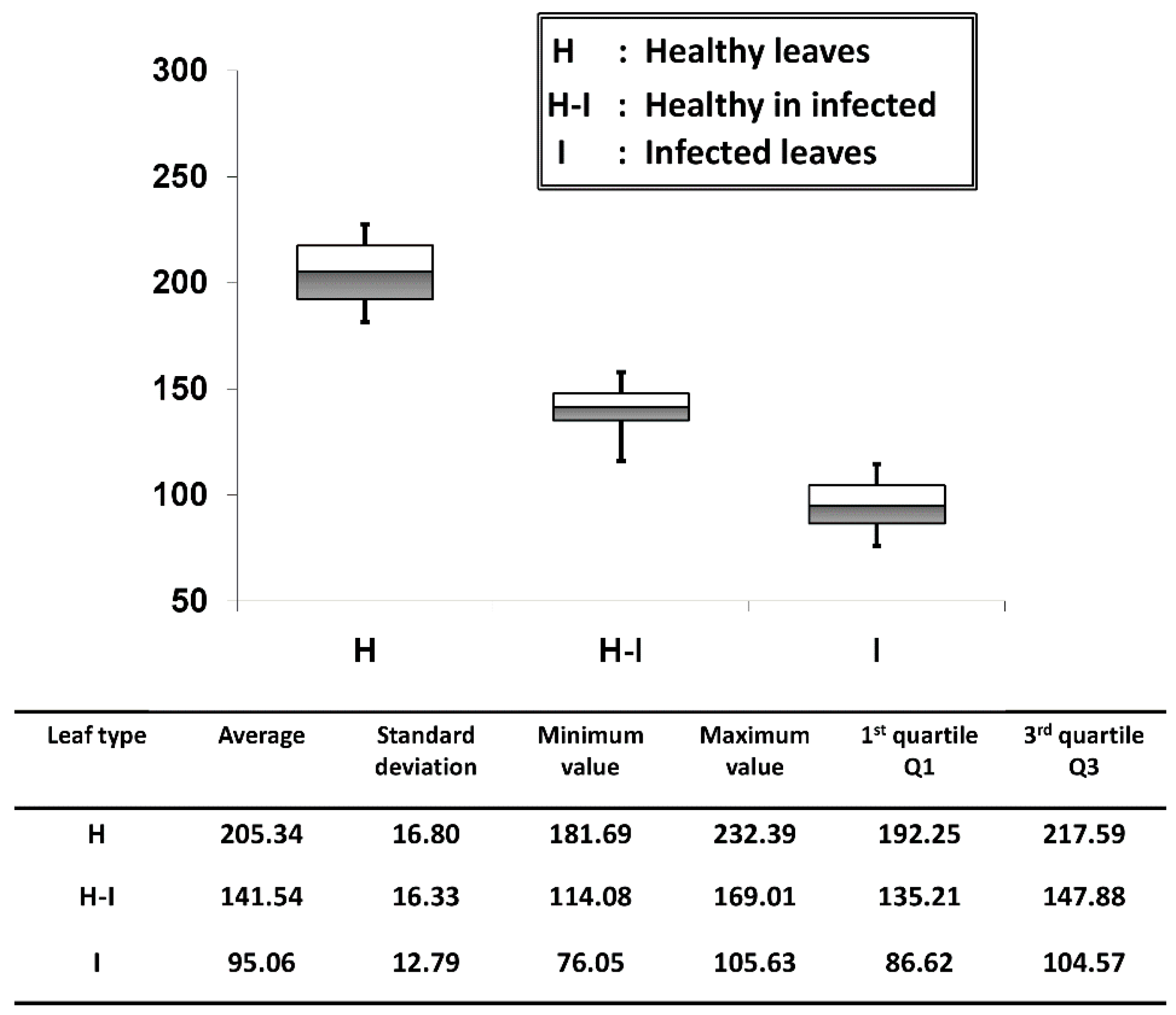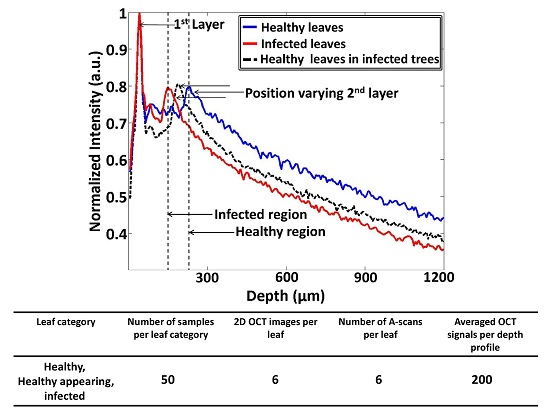Optical Inspection and Morphological Analysis of Diospyros kaki Plant Leaves for the Detection of Circular Leaf Spot Disease
Abstract
:1. Introduction
2. Materials and Methods
2.1. Preparation of Plant Leaf Samples
2.2. SS-OCT Experimental System
3. Results
3.1. Two-Dimensional Morphological Inspection
3.2. CLS Disease Inspection
3.3. Histological Analysis
3.4. Average Thickness Evaluation of Leaf Cross-Sectional Layers
4. Discussion and Conclusions
Acknowledgments
Author Contributions
Conflicts of Interest
References
- Berbegal, M.; Pérez-Sierra, A.; Armengol, J.; Park, C.; García-Jiménez, J. First report of circular leaf spot of persimmon caused by Mycosphaerella nawae in Spain. Plant Dis. 2010. [Google Scholar] [CrossRef]
- Kwon, J.-H.; Park, C.-S. Ecology of disease outbreak of circular leaf spot of persimmon and inoculum dynamics of Mycosphaerella nawae. Res. Plant Dis. 2004, 10, 209–216. [Google Scholar] [CrossRef]
- Vicent, A.; Bassimba, D.; Intrigliolo, D. Effects of temperature, water regime and irrigation system on the release of ascospores of Mycosphaerella nawae, causal agent of circular leaf spot of persimmon. Plant Pathol. 2011, 60, 890–908. [Google Scholar] [CrossRef]
- Berbegal, M.; Pérez-Sierra, A.; Armengol, J.; García-Jiménez, J. Circular leaf spot caused by Mycosphaerella nawae Hiura & Ikata: A new disease of persimmon in Spain. Bol. Sanid. Veg. Plagas 2010, 36, 213–223. [Google Scholar]
- Vicent, A.; Bassimba, D.D.; Hinarejos, C.; Mira, J.L. Inoculum and disease dynamics of circular leaf spot of persimmon caused by Mycosphaerella nawae under semi-arid conditions. Eur. J. Plant Pathol. 2012, 134, 289–299. [Google Scholar] [CrossRef]
- Rizzolo, A.; Vanoli, M.; Cortellino, G.; Spinelli, L.; Contini, D.; Herremans, E.; Bongaers, E.; Nemeth, A.; Leitner, M.; Verboven, P. Characterizing the tissue of apple air-dried and osmo-air-dried rings by X-CT and OCT and relationship with ring crispness and fruit maturity at harvest measured by TRS. Innov. Food Sci. Emerg. Technol. 2014, 24, 121–130. [Google Scholar] [CrossRef] [Green Version]
- Cajuste, J.F.; García-Breijo, F.J.; Reig-Armiñana, J.; Lafuente, M.T. Ultrastructural and histochemical analysis reveals ethylene-induced responses underlying reduced peel collapse in detached citrus fruit. Microsc. Res. Tech. 2011, 74, 970–979. [Google Scholar] [CrossRef] [PubMed]
- Berbegal, M.; Mora-Sala, B.; García-Jiménez, J. A nested-polymerase chain reaction protocol for the detection of Mycosphaerella nawae in persimmon. Eur. J. Plant Pathol. 2013, 137, 273–281. [Google Scholar] [CrossRef]
- Fercher, A.; Hitzenberger, C. Optical coherence tomography. Prog. Opt. 2002, 44, 215–302. [Google Scholar]
- Fujimoto, J.G. Optical coherence tomography. Comptes Rendus Acad. Sci. Ser. IV Phys. 2001, 2, 1099–1111. [Google Scholar] [CrossRef]
- Cense, B.; Nassif, N.; Chen, T.; Pierce, M.; Yun, S.-H.; Park, B.; Bouma, B.; Tearney, G.; de Boer, J. Ultrahigh-resolution high-speed retinal imaging using spectral-domain optical coherence tomography. Opt. Express 2004, 12, 2435–2447. [Google Scholar] [CrossRef] [PubMed]
- Drexler, W.; Morgner, U.; Ghanta, R.K.; Kärtner, F.X.; Schuman, J.S.; Fujimoto, J.G. Ultrahigh-resolution ophthalmic optical coherence tomography. Nat. Med. 2001, 7, 502–507. [Google Scholar] [CrossRef] [PubMed]
- Fried, D.; Xie, J.; Shafi, S.; Featherstone, J.D.; Breunig, T.M.; Le, C. Imaging caries lesions and lesion progression with polarization sensitive optical coherence tomography. J. Biomed. Opt. 2002, 7, 618–627. [Google Scholar] [CrossRef] [PubMed]
- Cho, N.H.; Lee, J.W.; Cho, J.-H.; Kim, J.; Jang, J.H.; Jung, W. Evaluation of the usefulness of three-dimensional optical coherence tomography in a guinea pig model of endolymphatic hydrops induced by surgical obliteration of the endolymphatic duct. J. Biomed. Opt. 2015. [Google Scholar] [CrossRef] [PubMed]
- Cho, N.H.; Park, K.; Kim, J.-Y.; Jung, Y.; Kim, J. Quantitative assessment of touch-screen panel by nondestructive inspection with three-dimensional real-time display optical coherence tomography. Opt. Lasers Eng. 2015, 68, 50–57. [Google Scholar] [CrossRef]
- Verboven, P.; Nemeth, A.; Abera, M.K.; Bongaers, E.; Daelemans, D.; Estrade, P.; Herremans, E.; Hertog, M.; Saeys, W.; Vanstreels, E. Optical coherence tomography visualizes microstructure of apple peel. Postharvest Biol. Technol. 2013, 78, 123–132. [Google Scholar] [CrossRef]
- Li, M.; Verboven, P.; Buchsbaum, A.; Cantre, D.; Nicolai, B.; Heyes, J.; Mowat, A.; East, A. Characterising kiwifruit (Actinidia sp.) near skin cellular structures using optical coherence tomography. Postharvest Biol. Technol. 2015, 110, 247–256. [Google Scholar] [CrossRef]
- Clements, J.; Zvyagin, A.; Silva, K.; Wanner, T.; Sampson, D.; Cowling, W. Optical coherence tomography as a novel tool for non-destructive measurement of the hull thickness of lupin seeds. Plant. Breed. 2004, 123, 266–270. [Google Scholar] [CrossRef]
- Lee, S.-Y.; Lee, C.; Kim, J.; Jung, H.-Y. Application of optical coherence tomography to detect cucumber green mottle mosaic virus (CGMMV) infected cucumber seed. Hortic. Environ. Biotechnol. 2012, 53, 428–433. [Google Scholar] [CrossRef]
- Lee, C.; Lee, S.-Y.; Kim, J.-Y.; Jung, H.-Y.; Kim, J. Optical sensing method for screening disease in melon seeds by using optical coherence tomography. Sensors 2011, 11, 9467–9477. [Google Scholar] [CrossRef] [PubMed]
- Lee, C.-H.; Lee, S.-Y.; Jung, H.-Y.; Kim, J.-H. The application of optical coherence tomography in the diagnosis of marssonina blotch in apple leaves. J. Opt. Soc. Korea 2012, 16, 133–140. [Google Scholar] [CrossRef]
- Chow, T.H.; Tan, K.M.; Ng, B.K.; Razul, S.G.; Tay, C.M.; Chia, T.F.; Poh, W.T. Diagnosis of virus infection in orchid plants with high-resolution optical coherence tomography. J. Biomed. Opt. 2009. [Google Scholar] [CrossRef] [PubMed]
- Meglinski, I.; Buranachai, C.; Terry, L. Plant photonics: Application of optical coherence tomography to monitor defects and rots in onion. Laser Phys. Lett. 2010. [Google Scholar] [CrossRef]
- Ullah, H.; Hussain, F.; Ahmad, E.; Ikram, M. A rapid and non-invasive bio-photonic technique to monitor the quality of onions. Opt. Spectrosc. 2015, 119, 295–299. [Google Scholar] [CrossRef]







© 2016 by the authors; licensee MDPI, Basel, Switzerland. This article is an open access article distributed under the terms and conditions of the Creative Commons Attribution (CC-BY) license (http://creativecommons.org/licenses/by/4.0/).
Share and Cite
Wijesinghe, R.E.; Lee, S.-Y.; Kim, P.; Jung, H.-Y.; Jeon, M.; Kim, J. Optical Inspection and Morphological Analysis of Diospyros kaki Plant Leaves for the Detection of Circular Leaf Spot Disease. Sensors 2016, 16, 1282. https://doi.org/10.3390/s16081282
Wijesinghe RE, Lee S-Y, Kim P, Jung H-Y, Jeon M, Kim J. Optical Inspection and Morphological Analysis of Diospyros kaki Plant Leaves for the Detection of Circular Leaf Spot Disease. Sensors. 2016; 16(8):1282. https://doi.org/10.3390/s16081282
Chicago/Turabian StyleWijesinghe, Ruchire Eranga, Seung-Yeol Lee, Pilun Kim, Hee-Young Jung, Mansik Jeon, and Jeehyun Kim. 2016. "Optical Inspection and Morphological Analysis of Diospyros kaki Plant Leaves for the Detection of Circular Leaf Spot Disease" Sensors 16, no. 8: 1282. https://doi.org/10.3390/s16081282





